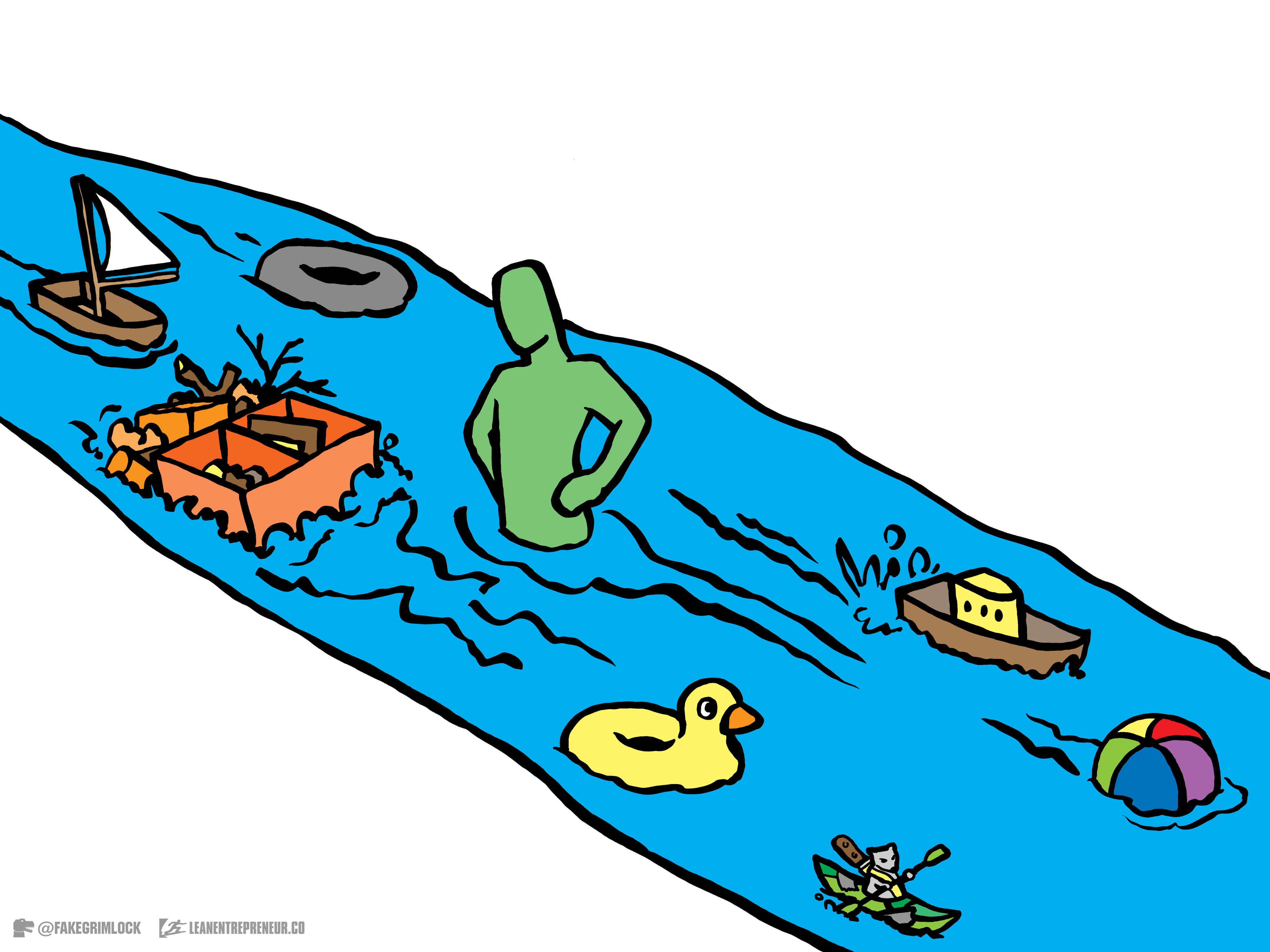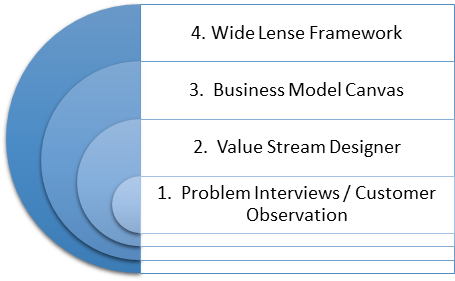Humans Cannot Predict the Future.
We would all love to be able to predict which ideas are going to be the big ones. You just got done with an incredibly powerful brainstorming session and you look over to see one of your senior leaders with a scowl on his/her face. They are annoyed because they don’t feel like there are any “big” ideas the team came up with. The problem with this perspective is that, at from this early vantage point, it is impossible to predict which ideas will be big and which ones will be flops.
 You have no idea which idea will work best until you are able to get the ideas in front of real customers and begin running behavioral experiments to see what sticks for them. But — If you can’t predict which ideas will be the biggest and the baddest, how do you decide which ideas to start with?
You have no idea which idea will work best until you are able to get the ideas in front of real customers and begin running behavioral experiments to see what sticks for them. But — If you can’t predict which ideas will be the biggest and the baddest, how do you decide which ideas to start with?
Searching
Since the path to a successful new venture is never linear, I would recommend that you start with the idea that you BELIEVE will have the biggest impact on your customer and that the team is most passionate about.
I recommend these two criteria assuming that the team understands that they cannot predict the future, and that it will be very likely that they will be exploring MANY of the ideas they just came up with. They are merely tying to choose a place to start.
The diagram to the right shows a small portion of a typical search for a business. You start with a single idea, run some experiments with customers, conduct some customer development, etc. You stand back and look at all of the data and try to generate some insights. Next, you apply these insights to your original business idea. This process ends up leading you down an entirely new path.
Since my background is in software development, I like to think of this like branches in a code repository. Since you have no idea which ones the customer is going to love, you build a few and let the customer’s behavior tell you which branches to merge and which ones to prune. The great thing about this is that you get to drop the code, but keep the insights you gleaned about your customers in the process.
Search Milestones
I plan to write on this topic at length, but I thought it was important to showcase some of the milestones in the search. As you communicate with leadership it will be extremely important for you to be able to showcase where you are. Otherwise, from their perspective, it will look like they have a schizophrenic team with a complete lack of focus.
Prove that your solution will solve the customer’s problem – (MVP) – Using rapid experimentation and prototyping you must now prove that your Minimum Viable Product (MVP) will actually solve the customer’s problem. This typically only requires 1-2 features in a product to do so. I would recommend using the Lean Entrepreneur Value Stream exercise to design your MVP based on customer needs.
Prove that customers will pay for it – Now that you have proven that you can solve the customer’s problem with your MVP, you should move to testing your pricing model and strategy. If you can’t get customers (that you’ve already spent significant time learning about and working with) to pay for your product, how will you get customers that don’t know you to pay?
Prove that you can acquire customers – Next, you need to test your possible marketing channels. Which channels work best for your customer? Which ones are least expensive? Most expensive? Can you consistently acquire customers through your marketing channels?
Prove that you can deliver the solution for less than the customer will pay (ROI) – Now that you’re able to acquire paying customers you need to start looking at your costs to market and deliver the solution. What can you optimize to deliver positive ROI? Are your margins large enough to warrant moving forward with this business model?
Prove that you can scale this into a business worth running – The final milestone is to test your business model to ensure that it can scale up. As you add more customers do you maintain similar margins or do they increase as you leverage economies of scale? Is this still work pursuing?
I hope that this perspective is valuable for other intrapreneurs out there. In the comments below; please let me know how you’re able to apply it and what you get hung up on in your enterprises.
read moreI Know How to Run Experiments, Now What (Part 3)
 It has always excited me to see so many great opportunities for intrapreneurs to change the culture inside their enterprises! But with any new skill you need to develop the ability to see patterns and understand the best areas to apply those new skills. I’m doing my best to provide some shortcuts for you. Here we are at part 3 of those shortcuts, but here are part 1 and part 2 in case you missed them.
It has always excited me to see so many great opportunities for intrapreneurs to change the culture inside their enterprises! But with any new skill you need to develop the ability to see patterns and understand the best areas to apply those new skills. I’m doing my best to provide some shortcuts for you. Here we are at part 3 of those shortcuts, but here are part 1 and part 2 in case you missed them.
Our employees could use a morale boost
Whether it comes up as a result of your annual employee survey, skip level sessions or some other interaction, there are always situations where morale gets a bit low. Often times this is because we feel powerless as employees. Things move, shift and get ripped out from under us. Other times we need a pick me up because we are drinking from the fire-hose and not feeling like we’re making great progress at understanding a new situation.
Regardless of what this looks like in your area you can usually find opportunities to get that boost through rapid experimentation. I would recommend that you get some customer empathy and a rough understanding of the reasons your team / organization is down in the dumps.
Once you have some ideas as to what problems exist (based on what employees say), you can then pull the team together for a quick brainstorming session. Ask the team something like “In what ways might we fix this problem ______ we identified?”. Come up with at least 50 possible solutions for the problem and then prioritize the list based on whatever criteria are most important to your organization.
Now that you have a list of possible solutions to the problem, you can begin experimenting. You will quickly start seeing gaps between what employees said was important to them and how they behave. This will help you continue to tweak and re-prioritize your ideas list until you find a few different solutions for the different segments of employees that have the problem(s) you identified.
Coincidentally, this process is almost exactly the same as the process you follow to identify and build a new product based on customer needs.
Our customers keep asking for features that they don’t use
You’ve never had this issue with your customers, right? Customers always use what they ask for! Right….. (heavy sarcasm here). Anyway, the best way to deal with this situation is to utilize your rapid experimentation skills. Instead of building the feature the customers ask for you should come up with some creative experiments to make it appear that the feature exists and see how many of the customers attempt to use it.
For example: You are part of the HR Learning and Development team. You hear from senior leaders in multiple businesses that they would like a class about ethics. Rather than building the entire class or purchasing it from an external vendor, you add the course and description to your internal learning management system (LMS) with a class date a few months out and a decent price tag. You begin to market the class back to the business units and ask them to register for the class.
This demand test should QUICKLY show you whether there is real demand for the course inside your organization and how important the class really is (high price). You can follow up with everyone afterward to determine why they did or did not sign up for the course. These insights will quickly tell you exactly what the requirements for the class should be, how you should price it and what pieces are most important to your employees (customers).
This same scenario happens very frequently in product teams as well, so be on the look-out!
We’re getting ready to acquire a competitor
This is one of my favorite scenarios to apply lean startup principles and rapid experimentation skills. As enterprises we tend to be GREAT and doing due diligence for M & A. We verify financials, evaluate employees for cultural fit, evaluate technology and integration requirements, etc. In many cases acquisitions are done to acquire technology, customers and talent. There are MANY assumptions baked into this process, but one of the biggest ones that doesn’t get tested much is the customers.
We make assumptions that our existing customers are likely to purchase the new product or vice versa. We believe we will be able to cross-sell and up-sell both sets of customers. We believe it will be a 1+1=3 situation. If there wasn’t an ROI in this area, why even consider the acquisition?
You need to PROVE that the two customer bases are complimentary. Run some experiments that show this to be true during your due diligence process. It’s not that difficult to get some of the people from your sales team to jump in and try to conduct some of this selling, right? Will your existing customers pay the same prices or will they expect some sort of bundling discount? Does it improve or diminish their experience and lifetime value?
You need to have the answers to as many of these questions as possible before you pull the trigger.
What situations have you uncovered where you were able to experiment quickly to reduce risk? Please share in the comments below.
read moreI Know How to Run Experiments, Now What? (part 2)
Welcome to part two of “I Know How to Experiment, Now What?” If you missed part one, you can read about it here. My hope is to keep showcasing situations that you should keep an eye out for. If you spot these, they are great opportunities in your enterprise where you can apply your new rapid experimentation and customer empathy skills immediately.
Our existing sales / marketing tactics are not working for this new product
I frequently see organizational structures and operating mechanisms that won’t support new products. You have the tools to fix it!
For example: One of your innovation teams in the enterprise comes up with a great new product idea. They conduct some early research, work with customers and determine that it’s going to be your company’s next great product. They build the product and then come to your sales or marketing team to ask you to begin selling the product.
As a result you begin to reach out to existing customers using existing sales tactic and find that your sales numbers are far below that of your existing products. This disconnect is occurring because the sales / marketing processes for each product are unique. The likelihood that your existing product and the new product have exactly the same target customer segment is extremely unlikely.
Use your new found experimentation and customer empathy skills to get inside the head of this new customer and understand what is important to them. Search for the sales or marketing processes, tactics and strategies that will work for this new product. Once you can do this successfully then you can create a reusable process.
Don’t assume that your existing processes will work for new products right out of the box.
We have a new product /service we would like to get to market quickly
In the enterprise, we often see that innovation is handled backwards from how it would work in a startup. We see that teams do a small amount of work to validate that their idea is interesting and then they start promoting it like mad to leadership to get additional time or funding to work on their idea.
The moment an unenlightened senior leader gets excited about the new idea they will immediately start applying their great execution skills to the project. They will begin asking many questions that will be focused on execution: When will this be ready to market to our customers? When can our sales team be trained? How much revenue will this generate during the next fiscal year?
While these are important questions to answer, they are typically asked too early and end up giving the new product team whiplash.
This is the type of situation where you can quickly apply your rapid experimentation skills. You can simply take the questions from senior leadership, convert them to “assumptions”, prioritize them and begin testing them like any other assumption. Following this process will also show the leader that you have taken their feedback to heart and allow you to bring back the answers based on customer-based experiments rather than a creative writing or PowerPoint exercise that we typically get pulled into in large corporations.
There are TONS of great places for you to apply your new skills. Keep on the lookout and hone your investigative skills. You’ll soon see opportunities daily!
Part 3 coming soon…
read moreI Know How to Run Experiments, Now What? (part 1)
The Lean Startup principle of rapid experimentation is spreading through enterprises like wildfire! At Intuit, we have at least 1,200 employees that have incredible experimentation capabilities. These folks are not only creating effective experiments, but extremely creative ones as well. One big problem is that many of these experiments are only occurring inside our two and five-day workshops.
As I follow up with teams long after the sessions, about 30% of the time I find that participants have not been able to identify where they can apply these new rapid experimentation skills in their daily work. I will eventually end up creating a module to help my students identify opportunities, but in the mean time, I thought I should create a quick series of posts to give you some specific situations to look for.
Here are three situations to be on the lookout for:
Our team is debating about which direction to head next
Imagine sitting in a team meeting and had a team member presenting a status update. They provide suggested next steps and then all hell breaks loose. It seems like everyone has an opinion or a dart to throw about where the project should head next.
This is usually a telltale sign that you can apply your new rapid experimentation knowledge. In this situation, you should capture ALL of the directions suggested, quickly prioritize the list and have each team member quickly test one of the suggestions before your next meeting. The entire team can come back to the meeting with real data to share and you can decide on the next direction to head.
We just made a crazy commitment (or got voluntold)
You join your boss for your regular 1-on-1 time and she has some “news” to share with you. He just got back from a staff meeting and is informing you that the team needs to be able to meet a fresh new goal within the next 6 months. You will need to increase a specific business metric (sales, conversions, NPS, etc) by 10%! He has a few ideas as to how you might be able to make this work.
This situation is ripe for the application of rapid experimentation. Your boss has some assumptions about the fact that these ideas will get you to the goal line. Take a few of the ideas and spend a few days quickly testing them. Come back to your boss with specific examples of how each idea may or may not work. Share with him the amounts you feel you can move the metrics with each idea and then FOCUS on 1-2 of the ideas to follow through on.
Our partners / vendors are not moving quickly enough
Unfortunately (or fortunately) in the enterprise, most development work is done through partner teams or external vendors. Because of this, they are usually interacting with you instead of directly connecting with the customer of your product. In addition to this disconnection, they are also trying to focus on delivering for multiple stakeholders.
What if you could make a very small request from your partner and/or vendor? With this request you can provide data showing a positive impact on your end customer and possibly even a rough ROI calculation that’s not pulled from thin air.
In my experience, the partner will be very happy to fit your small request into the front of their development queue. You have something that most of their other stakeholders do not have: proof!
Another great approach for this situation is to bring the partner / vendor along for the ride. Have them join you in the creation and execution of the experiments. Not only will the relationship get stronger, but they might be able to begin to apply the techniques as well. You can move quickly TOGETHER!
I will put together a few more posts with other situations I have spotted throughout my travels. In the meantime, what situations are you seeing as opportunities?
read moreLean Entrepreneur Value Stream + NPS = Customer Love

As many of you have already seen, I am a strong proponent of the use of the Net Promoter Score (NPS). It is an extremely powerful way to measure the value you’re providing to your customers. NPS helps you measure how often you are exceeding your customer’s expectations and provides a rough gauge to know how many customers may be talking (positively or negatively) to their friends about your product.
During the workshops and coaching sessions I’ve noticed a consistent pattern. Teams have no idea how to actually “delight” their customers (score a 9 or 10 NPS). The net promoter and delight concepts get tossed around like a ragged teddy bears. People understand what terms mean, but have no idea how to make the concept tangible.
Fortunately, Brant Cooper and Patrick Vlaskovits recently released their second book titled “The Lean Entrepreneur”. In this book they introduce a new tool called the Value Stream Designer (I’ll refer to it as VSD for the remainder of this article). I’ve had the pleasure of facilitating some workshops that utilize the tool.
In my opinion the VSD does a great job of helping teams keep from over-building their minimum viable product, hypothesize about what their customer actually expects and determine EXACTLY they are going to build! Additionally it facilitates getting your entire team on the same sheet of music as early as possible which is critical to your ability to be successful. I’m not going to go into detail about the actual mechanics of the VSD as Patrick and Brant already do a great job of covering that in The Lean Entrepreneur. I’ll stay focused on tips and tricks I’ve learned as a result of coaching many teams to use the tool.
Keep From Over-Building by Designing the Minimum Viable Product
Unfortunately, I have yet to see a single team that has been able to focus on building exactly what is necessary to solve their customer’s single problem right out of the gate. They get excited and want to build far more than is necessary. This observation includes many seasoned business professionals and Lean Startup experts. This problem is difficult to see because your team has their noses to the grindstone and are trying to move quickly. The VSD can help you solve this forest for the trees problem.
After you have a basic level of customer empathy; you know what problems you solve for each customer and think you know how your solution will fit into their workflow. I recommend that you print a large wall poster ($10 at Kinko’s) and have your entire team use post-its to fill in the VSD. You should start with the boxes inside the “Satisfied” section and then move on to the “Hopeful” section.

During this process you need to frequently push your team to get very specific about the values they write down. The more specific they can get the better. If it feels uncomfortable then you’re doing it right. Additionally, you should keep in mind that these values are nothing more than hypotheses. Every one of these are guesses that you’ll need to convert into facts using experiments with your target customers.
If you end up being correct about the hypotheses in these two boxes then you should have identified how you can ensure a net promoter score of 7 or 8 (neutral). Customers that make it to this point should have had their expectations met. We will get to the “Passionate” box (NPS of 9 or 10) later in the exercise.
Hypothesize About What Your Customer Actually Expects
As you filled out the “Satisfied” and “Hopeful” boxes on the VSD you will have come across the details of what you should be promising to your customers. You’ve just hypothesized about what impact you can make on them and how you will go about doing it.
You should now continue to move backward through the rest of the VSD (Convinced, Trusting, and Intrigued) and you will begin to dive into the exact touch points where the promises you identified above will initially be placed in front of your customers inside the conversion / sales funnel.
Continue thinking about the promises you had to make in the Satisfied and Hopeful boxes as you fill out the rest of the VSD.
Your final step to complete the VSD is to fill out the boxes inside “Passionate”. This section is typically based on a big insight gathered from watching your customers use your product over time and from experiments you’ve run on those customers. I recommend taking a starting guess about what things you might do to try to create a passionate customer, but it will require many experiments to determine what is actually valuable to the customer.
You now have a map of all of the hypotheses you’re making about the value proposition, funnel and how to actually delight your customer through the product. Additionally, this exercise has a tendency to create shared vision among the team members. Typically teams start out way too high level and it appears that the team has agreement on what they are actually building, but in reality they are all viewing the solution differently.
What about the Business Model Canvas?
One of the most painful things about learning these Lean Startup methodologies is the massive number of tools, frameworks, and puzzles available to teams (entrepreneurs and intrepreneurs). One of the tools that has taken our community by storm is the Business Model Canvas.
We all agree that in the early stages of a new endeavor we are looking for product-market fit. In other words, have we identified a specific customer, problem and solution that complement each other so perfectly that customers begin to pull the product from our hands?

I like to think of the Value Stream Designer as a tool to use to guide our first experiments and stay focused on the riskiest portions of the business model (customer + value proposition). Once you feel confident that your solution will really solve the customer’s problem and you can reliably attract customers then you should move on to looking at the entire business model (business model canvas).
After reducing risk in the larger business model canvas you should move to using the Wide Lens Framework to ensure that you don’t have any co-innovation and/or ecosystem risks in bringing your product to market.
If you can wrap your head about when to use each of these tools then you can safely pull it out of your tool belt at the right time and increase your chances of success. As always, I’d love to hear your feedback. Share how you are applying these tools in your world.
read moreTurbo Charge Enterprise Human Resources with Lean Startup
What we learned over the last year has been amazing. We’ve found that our employees feel more empowered to do their work, to innovate and to speak the language of leadership. They feel more in control of their careers and have many open doors to pursue as a result. On the flip side, employees are also more aware of the challenges in their own organizations when it comes to running rapid experiments, and have begun to ask more from their leadership in supporting them in this innovation journey.
 Just over a year ago I was hired as the first product manager for Intuit’s human resources group. I am responsible for products and services and will help employees take charge of their careers inside Intuit. As I’ve learned over the last year this is a pretty cutting edge position and there aren’t many enterprises applying this type of thinking inside HR.
Just over a year ago I was hired as the first product manager for Intuit’s human resources group. I am responsible for products and services and will help employees take charge of their careers inside Intuit. As I’ve learned over the last year this is a pretty cutting edge position and there aren’t many enterprises applying this type of thinking inside HR.
The first gap that we’ve noted over the last year is that most of our HR employees didn’t view their work as a product or a service. This gap caused us to view customer interactions as simple transactions. We didn’t look to measure how much we were delighting our customers, and in many cases didn’t even refer to our customers as customers.
Once we began changing this product mindset we quickly realized that many of us did not have the skills necessary to gather deep customer empathy. How could we focus our products & services for specific customers if we don’t understand what’s important to them? To resolve this gap we began leveraging our Innovation Catalysts to coach & mentor teams to strengthen these skills inside the organization. Additionally, we promoted one of our Innovation Catalysts to a product experience lead for the entire organization. The goal here was to turbo-charge the capabilities of the organization by having a single individual focused on it.
The second gap we identified was that HR employees were not using Lean Startup and Rapid Experimentation as a method of agile operation. Teams were operating in large siloes and the membership was not very cross-functional. Teams understood what it meant and why it was important, but not how to actually break their solutions down into assumptions and build super-small experiments to test them.
To try to solve this problem we utilized our Lean StartIN 2 day events to turbo-charge the teams. We had them bring their product or service to the class, and put them through an extremely intense 2 days of practical application of Lean Startup principles. [Read more about the course we created] This course helped HR employees better understand the behaviors of their customers, helped them refine their customer segments, and ultimately reduce risk in their projects.
With all products (including our Lean StartIN course) it is important to understand how it impacts your customer. In our case we followed up with participants of the course a month after the completed it to find out how it had impacted them personally. In addition to the positive benefits I described at the beginning of the post, we also identified that participants would get back to their daily work and feel that leadership was not making decisions fast enough and not clearing a path for them. They were moving faster than the rest of the organization! We’re working to address that issue separately and I won’t elaborate on it more here.
Now that the teams were moving quickly and focused on more specific customer segments we needed to solve another key problem we heard from our customers. What we were hearing from the business units was that they feel HR is buying / building tools and pushing them out into the organization. They felt that HR was not really working with them to solve specific issues.
The next phase of our journey is to identify how we can get the business units to pull us into key issues and partner with them to solve the issues using our products and services (or with new ones). As with any journey you have to keep making consistent steps and the adventure is in to trip and not arriving at the destination.
What are you seeing in your organizations? Post in the comments below.
Lessons Learned:
- Treat your HR teams like product teams – They should be able to produce positive ROI for their customers (employees) just like a product team. They should be able to move quickly just like a product team. They should create value for their customers just like a product team.
- Your employees are your customers – You should strive to delight them just as you would an external customer. If you can delight your employees then they can delight your external customers.
- You can improve employee engagement by empowering employees – Getting employees to behave like intrapreneurs, move quickly and make decisions based on customer data will put them head and shoulders above their peers. They will have the tools they need to solve any problem in any organization.







Connect With Me